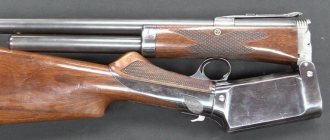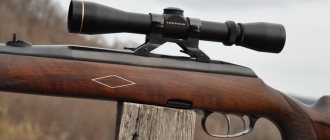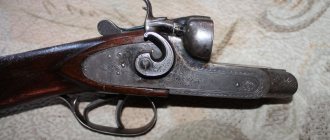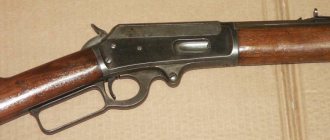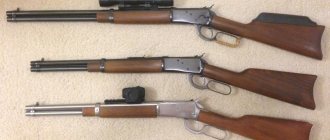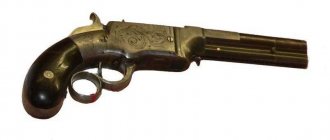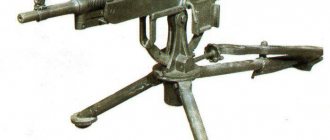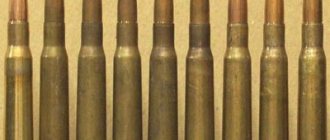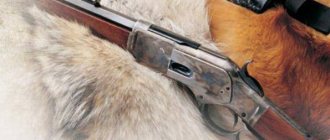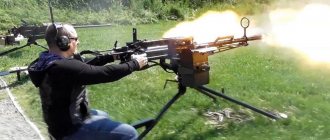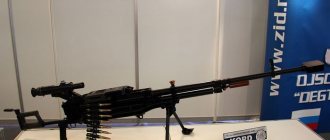The Marlin 1895 Hunting Rifle is a reloadable Henry action rifle that has been in production for over 100 years and is considered a national treasure and an iconic model among North American shooters. It differs from the Marlin 1884 in the shape of the bolt and the large hole, which is unofficially called the Big Bore.
Description Marlin 1895
Lever action carbine with a large caliber barrel. It has a large-caliber 45-70 Government (11.6 mm) centerfire bullet and very high stopping power.
The magazine is tubular, under-barrel. The window for ejecting spent cartridges is located on the right side of the receiver. It is also possible to install optical sights.
In this video we will explain what the Marlin 1895 is and how it is used.
Advantages and disadvantages
Timeless design. The carbine is from the authentic era of the Wild West, which determined its popularity in the USA with its cult of cowboy romance.
- The Henry Brace allows the shotgun to reload at speeds close to that of a semi-automatic rifle, combined with the powerful stopping power of .45-70 caliber bullets, making the shotgun ideal for large backcountry situations where you have to shoot a lot and quickly in the face of huge bears and wild boars. It is indispensable for game hunting.
- Due to the abundance of moving parts and hinges in the reloading mechanism, it is theoretically less reliable than a bolt-action rifle. In practice, this is such a lever that any stuck cartridge case can be pulled out and the resistance of the “evil” dirt can be overcome. It works great as long as you keep an eye on the weapon. In addition, since the rifle was originally designed to use black powder, a large amount of carbon remains in the components.
- There are some concerns about placing a centerfire cartridge in a tubular magazine. Although the bullets are blunt, the possibility of the seed penetrating and exploding upon impact or fall cannot be ruled out.
- Using an external trigger allows you to effectively control the condition of the weapon and check whether it is ready to fire. If necessary, the firing pin can be removed from the bolt carrier, ensuring safety even with a cartridge in the chamber during long travel. The shutter is designed in such a way that the shot occurs only after it is completely closed.
- The Henry eye makes it impossible or inconvenient to shoot from the point of impact. Because of this design, pistols of this design have been discontinued by the military in the past.
- The lack of protruding parts such as grips or bolt carriers makes it awkward to carry in a saddle holster. For this reason, it is popular among cowboys who often travel on horseback.
Ammunition of 45-70 caliber in Russia is inaccessible and expensive.
Weapons in the Movies: Jurassic World
Guns against dinosaurs - who will win?
Photo - Universal Pictures
On June 7, the sequel to the film “Jurassic World,” a revival of the legendary series about amusement parks with live dinosaurs, will be released. The first part came out filled to the brim with a variety of weapons. Let's explore how.
Glock 17
Park guards and employees of the In-Gen corporation are armed with this classic movie pistol. Did they manage to protect park visitors from lizards using 9x19 caliber? Figure it out for yourself.
Smith & Wesson Model 500
This hunting pistol looks more like a gun that can hurt a dinosaur. Perhaps that is why its owner, Barry, manages to survive the events of the film.
Heckler & Koch UMP45 and Heckler & Koch MP5K-PDW
The fact that In-Gen operatives are armed with these submachine guns clearly indicates that no one was preparing for the dinosaur uprising. People don't learn from the mistakes of the past.
Marlin Model 1895SBL
And this is already the real star of the film, along with Chris Pratt. This hunting rifle is not only incredibly beautiful (although the stainless steel body looks a little show-offy), but it is also really capable of killing, if not a dinosaur, then certainly an elephant. The chances of the gun returning in the sequel are extremely high.
The manufacturer’s website says that the Marlin Model 1895SBL can be used for hunting bear, deer, wild boar and... tyrannosaurus. Just a joke or a direct reference to the film?
Remington 870
Barry's main weapon is one of the most famous pump-action shotguns in the world. Previously, it was in service with the US Marine Corps. But at the beginning of the 21st century they began to be replaced by the newer Benelli M4 Super 90.
DRD Tactical Paratus
Quite a rare semi-automatic shotgun made in America. "Paratus" is Latin for "ready" and is part of the US Coast Guard's slogan - "Semper Paratus" - "Always Ready." Together with a laser and optical sight, the weapon looks terrifying at the same time.
M4A1, Heckler & Koch HK417, Heckler & Koch UMP45 and M249 SAW Paratrooper
This is the order in which the weapons of the In-Gen operatives are depicted in the photo above. Judging by the variety of weapons, the cooler mercenaries came to fight the dinosaurs “with their own.”
UTAS UTS-15
UTAS UTS-15 was developed as the “ultimate police gun,” that is, the best in the world. Strictly speaking, the idea was a failure: the weapon was endlessly criticized. That doesn't stop it from being fantastically cinematic. Look at the screenshot, is it quite possible to assume that an operative can win this fight with such and such a weapon?
GE M134 Minigun
The famous American “Minigun” produced by General Electric. Interesting fact: the film refers to a specific gun model as the M134, but the gunshot sound used in post-production is from a different machine gun, the Browning M2.
AT4
The only weapon with any effectiveness against dinosaurs. AT4 is the most popular anti-tank weapon in the modern world, which is produced in Sweden. It is produced by Saab, the same company that made cars.
CODA Net Gun
The most unusual weapon in the film, which is only surprising because it is real. It is produced by the company CODA; according to the American classification, the gun is not even a weapon, but a tool. In the film, it is fired directly into the face of the main villain, the fictional Indominus Rex. The lizard easily shakes off the net with one movement of its head.
Based on materials from IMFDB.com
Specifications
| Marlin 1895 | |
| Charge type | Lever mechanism |
| Caliber | .45-70 Clothes |
| Barrel | Round |
| Barrel length (mm) | 559 |
| Slots | 6 ballad style deep rifles |
| Groove pitch | 1:20″ |
| Magazine capacity | 4 |
| Stock | Half a bucket (American walnut) |
| Overall Length (mm) | 1029 |
| Weight without cartridge (kg) | 3,4 |
| Marlin 1895CB. | |
| Loading type | Lever mechanism |
| Caliber | .45-70 Gavament |
| Barrel | Hexagon |
| Barrel length (mm) | 660 |
| Slots | 6 right handed ballad type deep rifles |
| Groove pitch | 1:20″ |
| Magazine capacity | 9 |
| Stock | English straight, American walnut |
| Overall Length (mm) | 1130 |
| Weight without cartridge (kg) | 3,8 |
| Marlin 1895CBA | |
| Loading type | Lever mechanism |
| Caliber | .45-70 Govt. |
| Barrel | Hexagon |
| Barrel length (mm) | 470 |
| Slots | 6 ballad style deep rifles |
| Groove pitch | 1:20″ |
| Magazine capacity | 6 |
| Stock | English straight, American walnut |
| Total Length(cm) | 940 |
| Weight without cartridge (kg) | 3,6 |
| Marlin 1895G, Marlin 1895GS | |
| Loading type | Lever mechanism |
| Caliber | .45-70 Clothes |
| Barrel | Round |
| Barrel length (mm) | 470 |
| Slots | 6 ballad style deep rifles |
| Groove pitch | 1:20″ |
| Magazine capacity | 4 |
| Stock | English straight, American walnut |
| Length(cm) | 940 |
| Weight without cartridge (kg) | 3,18 |
Rifles, carbines, shotguns
Marlin Camp Carbine is an American self-loading carbine. It was designed by Mark White of , who is best known as the creator of the extraordinarily accurate .22-caliber silent rifle and the quietest carbine on the market, the Marlin Camp Carbine. A graduate of Colonel Jeff Cooper's American Pistol Institute, White is a successor to many of his views: complete confidence in the superiority of the .45 ACP cartridge over the 9x19 mm Parabellum cartridge, that any man is both an armed professional and and an ordinary citizen must be a master of the instant shot, that is, be able to fire the first shot quickly and accurately.
Design
The Marlin 1895 is a rifle with a tubular under-barrel magazine that is reloaded using a Henry lever mechanism.
O.Henry!
"VOLCANIK" WAS THE FIRST.
The gun itself is extremely interesting. This is the first weapon with a lever mechanism and an under-barrel tubular magazine. It was reloaded using a lever similar to Henry's brace, but with one finger - for a pistol, such a system seems quite logical. Nowadays you can find replicas of the “Vulcanic” chambered for a unitary cartridge. These replicas are deservedly popular among fans of Wild West weapons.
Rifles with a Henry brace, or Lever Action in American, have gained enormous popularity and in terms of total circulation are slightly behind the famous Kalashnikov. It is interesting that, despite their popularity, Lever Action rifles were not officially in service anywhere, although they had to fight. Most likely, this happened because the concept of a pistol cartridge in a long-barreled weapon was too innovative for that time, as was the design of the rifle itself. I remember the Mauser S-96, a legendary pistol that fought from the Boer War almost to the present day and was also not officially in service anywhere, although it was recommended to officers for independent purchase in both Russia and Germany.
| On the right side of the Marlin box mod. 1895 two windows: one for loading, the second for extracting the cartridge case. |
The Winchester 70, one of the first lever-action rifles, received its baptism of fire on June 25, 1876, in a battle with the American army, and on the side of the Indians. The clash occurred in Montana, near Little Big Horn, when soldiers of the Seventh Cavalry under the command of Lieutenant Colonel J. Custer attempted to clear out a Sioux settlement. The Indians expected such a turn of events and were well prepared. They gathered forces, purchased the most modern Winchester-70s at that time and a fair amount of ammunition. We remember from history that the Indians were sold mainly outdated weapons - percussion caps and even flintlocks. But this time, apparently, the thirst for profit won out, and the Sioux received brand new repeating rifles of .38 and .44 caliber. They were capable of firing at a rate of fire unimaginable at that time, 50–60 rounds per minute, and had magazines for 10–12 rounds, depending on the caliber and length of the barrel. The army was armed with good, reliable .45 caliber Spencers and Springfields, powerful, accurate, but single-shot. Their rate of fire strongly depended not even on the folding bolt, but on the location of the cartridge belt. When mounted on a rifle, it was high, then decreased when the shooter switched to a belt belt, and completely fell when he removed cartridges from pockets and other pouches. The only drawback of the Winchesters was the relatively weak revolver cartridge. This could only be compensated for by a sharp reduction in the distance to the enemy, which was done.
| The disconnector is clearly visible when the shutter is open. Its function is to prevent a shot from being fired when the bolt is unlocked. |
J. Custer conducted reconnaissance and found out that there were more Indians than expected, and arrogantly decided to carry out an attack.
Without waiting for reinforcements, he divided the detachment into two parts and attacked the Sioux settlement. The first detachment was ambushed (and we remember that in close combat the Indians had a three to four times superiority in rate of fire), suffered losses and retreated, not allowing them to break the distance; the Indians caught up and completely destroyed it. The second detachment did not expect that the resistance would be so strong and was scattered. Another detachment moving to reinforce him avoided the collision altogether, apparently impressed by the cannonade that stood over the camp. This was the debut of the combat use of Lever Action rifles represented by the Winchester-70. He did little to help the Sioux tribe historically, but he forced them to pay close attention to repeating rifles.
| AN EXCEPTION. Lever-action rifles appeared almost simultaneously with pump-action rifles, and, interestingly, initially both were rifled for revolver cartridges. Then their paths diverged: the pump-action ones firmly settled in the smooth-bore niche, the lever ones occupied the rifled one. But there are no rules without exceptions: there are several modifications of smoothbore lever guns, and one of them is the Winchester 92. A charismatic 12-gauge shotgun with a massive box and an under-barrel magazine. The gun has a large number of fans, and not only in the USA. The opposite example is the Remington 7600, a rifled pump action for rifle cartridges with a pointed bullet, which is important. This was achieved by using a box magazine instead of a tubular one. But all these are exceptions that only confirm the rule. |
Then the rifles fought gloriously and even made their mark in the First World War on the side of the Russian army.
An order was placed in America for several tens of thousands of rifles chambered for 7.62x54. The contract was far from completely fulfilled; these rifles were few and far between, and later they became a real decoration of collections. But Lever Action's main niche was and remains hunting. On the American continent, lever-action rifles have become an indispensable attribute of hunters and travelers. Due to the absence of protruding parts (bolt handles, magazine, etc.), the rifle is quickly stored in an oblong case, reminiscent of a knife sheath, and can easily be placed on a horse, in a car or even on a backpack, it is lightweight and always ready to shoot. If the cartridge is in the chamber, then it is enough to cock the hammer; if not, one movement of the guard, and you have a loaded weapon.
The popularity of the first rifles is explained by the successful choice of cartridge. The revolver cartridge was sufficient for hunting any game in North America, including bison. In addition, it is convenient to have both a revolver and a rifle chambered for one cartridge. A simple, reliable mechanism, unpretentiousness, tolerance for poor maintenance - all this determined the long and happy life of rifles with a Henry brace.
Having become acquainted with the history, let's move on to practice. While preparing this article, I was able to hold in my hands several samples of rifles with a Henry brace, and I want to introduce you to them.
WINCHESTER-1886
An original Winchester manufactured by the company between 1886 and 1892, with a powerful faceted barrel designed to accept lead, non-jacketed bullets and black powder. The inscription WINCHESTER, worn out from long use, catches the eye, once embossed in the metal and practically erased by decades of use. All mechanisms work normally, the cartridge mock-up is sent and ejected without delay. But she is over 120 years old! Of interest is the .44 WCF caliber stamp. The first letter is clear - Winchester, but the next two? CF is "center fire". At that time, an active transition from ring-fire cartridges to the now familiar cartridges with a primer in the center of the bottom of the case had just begun. These cartridges were called “center fire”. A little later, these letters disappeared, and the cartridge suitable for this rifle became known as .44-40. The letters WCF indirectly say that it is better to shoot only black powder cartridges from a rifle. The carbine box is open at the top; there is a window on the right for charging, closed by a spring-loaded door. The box is massive and durable, made from a single piece of metal.
| ROSSI-92. When the bolt is opened, the cartridge case is ejected through the receiver, which is open at the top. The carbine is loaded through the window on the right side of the receiver. |
The store is interestingly laid out.
It does not have any cartridge interceptors; the cartridge is held by the feed tray. This is an extremely simple and reliable design, its only feature is that the cartridge must be of a strictly defined length; a short cartridge will lead to jamming of the feed mechanism. The bolt is locked with two wedges at the rear, this is a classic locking, reliable and durable. The wedges are controlled by the reloading lever and move downwards, unlocking the bolt when reloading. Then, when the bracket moves forward, through a system of levers, the bolt moves back, cocks the hammer, and the cartridge case is extracted and the feed tray with a new cartridge is raised. When the reloading lever moves back, the cartridge from the tray is sent into the barrel, the wedges, rising, lock the bolt, the tray lowers, opens the magazine, and the cartridge from the magazine enters the tray. The shutter mirror is designed in an original way. The entire lower part is spring-loaded and moved forward, while performing two functions. The first is a reflector. The sleeve is constantly spring-loaded; when the bolt moves back, it (or the cartridge) is, as it were, wedged between the lower part of the cylinder and the chamber. Once the case leaves the chamber, the deflector is released and ejects the case from the case. The advantages are obvious: no matter how slowly the shutter opens, extraction will always be reliable. The second function is to prevent a shot from being fired when the shutter is not closed. Since part of the bolt is pushed forward until the bolt is closed, the firing pin will simply not reach the primer. The simplicity and thoughtfulness of the design are amazing; you just need to note that it is “paid for” by a huge amount of work on milling and fitting parts that are quite complex in configuration. Another little touch that shows attention to detail: the released trigger overlaps the aiming line, signaling that you are about to fire, but the weapon is not ready to fire. MARLIN MOD-1895
A modern replica of our own model. A very good and powerful rifle in .45–70 caliber. In terms of dimensions, it is not much larger, but significantly heavier. The .45–70 cartridge is powerful, accelerating a 21-gram bullet to 500 m/s. It can be safely recommended for all forest hunting in Russia. Up to a distance of 150 m, it has a “flat” trajectory, and when zeroing at 100 m, corrections from 0 to 150 m can be neglected. The Marlin box is closed, with two windows on the right side. The bottom one is for charging, with a door. The top one is for cartridge case extraction. The reflector is installed in the box, and when reloading it is advisable to vigorously retract the bolt to ensure reliable ejection of the cartridge case. The bolt is locked with one wedge, which enters from below; when closed, it supports the part that transmits the blow from the trigger to the firing pin - this is how it is impossible to fire a shot when the bolt is not closed. The gun is solid, powerful and maneuverable. I think this is a good choice for driven hunts for medium and large animals.
ROSSI-92
A copy of Winchester 92 from the Brazilian company Puma. A very good copy. To meet modern standards, a safety pin has been added, which is mounted on the bolt and locks the firing pin. The firing pin is completely blocked, while reloading, cocking and even triggering is possible - the shot will not fire. The second improvement is the trigger locking key. You just need to turn it, and that’s it: the rifle is completely locked - you can’t cock the trigger or move the bolt. Quite a convenient feature. Another useful innovation is a coiled mainspring instead of the plate spring on the original (it is simpler, more reliable and more durable). We also managed to get acquainted with a .44 mag caliber rifle. Here, in addition to the differences described, cartridge interceptors are installed in the magazine. The cartridge is released from the magazine when the bolt is pushed forward all the way, while the tray is lowered and the cartridge falls onto it. Otherwise, it works like a Winchester 1886. The energy of the .44 mag cartridge is enormous for a revolver, but modest for a rifle, and although special “hot” cartridges are produced, it is still difficult to recommend such a cartridge for hunting animals weighing more than 40-50 kg. HENRY GB
This is a rifle from the company that gave the name to the whole group. Unfortunately, of the entire line, only rifles in .22 caliber are supplied to us. I was able to get acquainted with the .22 WMR caliber rifle in the top version. Yellow box, expensive wood, heavy octagonal trunk. The rifle has a classic look and the shape of the box strongly resembles a Winchester 70. I liked the smooth operation of the mechanisms. It felt like the shutter was moving on rollers, the movement was smooth and soft. The box is closed, with one window on the left for cartridge case extraction. Charging occurs through a special hole in the front of the magazine. To do this, you need to turn the washer and pull the tube with the spring out of the magazine body, then fill the magazine with cartridges through the hole and insert the tube with the spring back until it stops - that’s it, the magazine is loaded, you can shoot. This loading system is convenient for recreational shooting. For hunting or self-defense, I would prefer an option with charging through a window in the box.
A common drawback of all of the rifles listed is disassembly. For it you need to have a whole set of slotted screwdrivers; in the Rossi passport, for example, it says that “if disassembly is necessary, you should contact a gunsmith.” Such an unexpected turn after our tradition of “disassembling weapons without additional tools” seems downright wild. But what can you do! Personally, I really like the Lever Action rifles, although I don’t consider them as a hunting weapon. For me, this rifle is more of a companion, you can take it with you on a trip, it’s nice to come to the shooting range with it, but for hunting I’m closer to a bolt gun or a semi-automatic. Perhaps this is because I did not have levers for rifle cartridges in my arsenal.
WAS THERE A HENRY?
Met with an old acquaintance. — What are you writing about now? - he asked. - O.Henry. “Did you know that Henry didn’t invent the staple?” “You mean Smith and Wesson’s Volcanic?” He, in my opinion, appeared at the same time with a staple. - Yes, like before. - Interesting! Need to check…
This conversation reminded me of the old story about the Vulcanic pistol, which appeared in the mid-19th century, around the same time as the Henry brace rifles. Upon checking, I discovered that the patent for the Volcanic was registered in 1854, and for Henry in 1860. It turns out that partners Daniel Smith and Horatio Wesson, the authors of Volcanic, are the pioneers of lever systems.
| The bolt is open, the cutout in the bolt for the locking wedge is clearly visible. |
For the first time in history, Vulcanica used a caseless unitary cartridge, consisting of a bullet with a cavity in which gunpowder and an initiating charge (capsule) were placed. The cartridge turned out to be weak and expensive. The advantages include the simplification of the design: the steel does not need an ejector and reflector, and even a window for ejecting the cartridge case is theoretically not needed. True, if it misfired, it became difficult to remove the cartridge, but we must remember that “yesterday” the weapon was a percussion weapon, and its discharge is generally a separate story, in comparison with which knocking a misfired cartridge out of the barrel of a “Vulcanic” is simply child’s play. The pistol was mass-produced, only 1900 copies, the latest versions were already chambered for a unitary cartridge.
| SAFETY FIRST. The requirements of the new time are safety. The Rossi-92 is equipped with a safety lock that blocks the firing pin, while the hammer is cocked, the bolt jerks, but a shot is impossible. The second innovation is the key. By locking the trigger, the owner completely blocks all the mechanisms of the rifle: it is impossible to cock the hammer, it is impossible to jerk the bolt. |
It is known from history that at first Smith and Wesson founded the company and launched the production of Volcanic, but then things went badly, the company closed, and they implemented the next project together with Winchester. Then, for unknown reasons, Winchester, Smith and Wesson parted ways, and the latter again organized the company for the production of Smith and Wesson revolvers, which later made them famous. Winchester continued to make weapons, including lever-action rifles.
| The Vulcanic pistol can be considered the ancestor of all lever systems. |
Alexander Kudryashov May 28, 2014 at 00:00
Operating principle
Marlin (Marlin) 1895 - large-caliber carbine with a Henry bracket, enduring cowboy romance
The Marlin 1895 is a weapon that is reloaded using the Henry Lever Action. It has been in production for over a hundred years and is considered a cult model among North American shooters, almost a national treasure. It differs from the Marlin 1884 model in the shape of the bolt and the large caliber, for which it received the unofficial name Big Bore.
Disassembly
- Place the hammer in the half-cocked position, turn on the safety and vigorously pull the guard several times, emptying the magazine.
- Lower the bracket, unscrew the hinge screw and remove it from the receiver.
- Remove the bolt from the receiver.
- Remove the extractor lever from the receiver.
More complete disassembly at home is not recommended.
The price for Marlin 1895 (models from basic to SBL) ranges from 48 to 50 thousand rubles. The same amount will have to be paid, for example, for CZ 512.
Marlin 1895 GBL Carbine, Lever Action, .45-70 Government, 18.5″ Barrel
